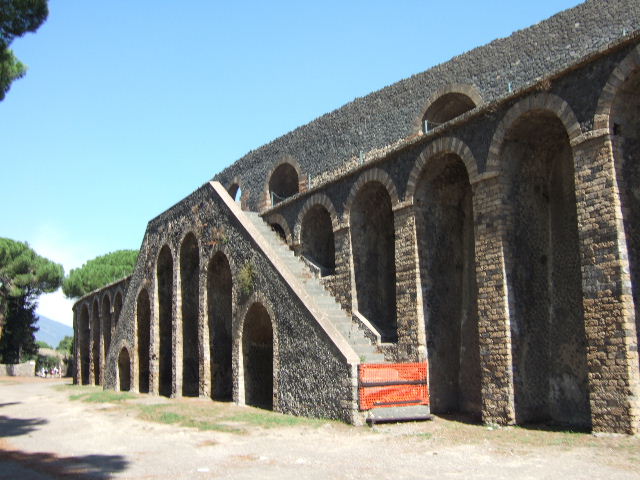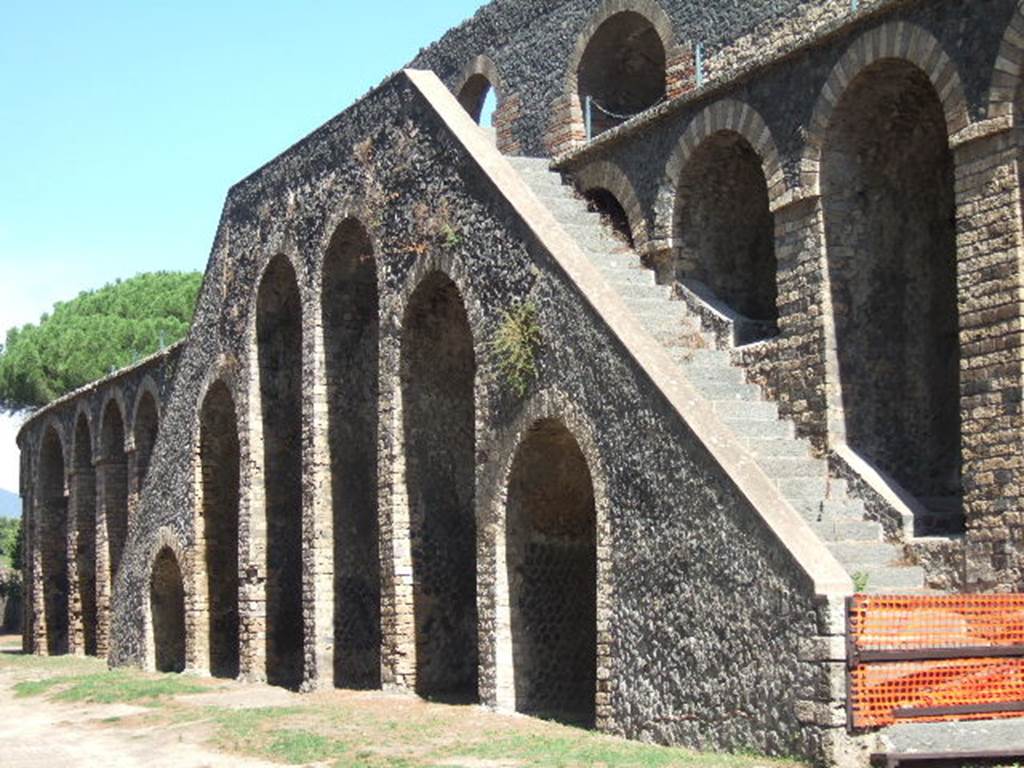II.6 Pompeii. Anfiteatro or Amphitheatre.
First excavations 1748, then abandoned.
Completely excavated between 1813 and 1816. Bombed in 1943.
(Originally when excavated, this was
numbered as Reg. II,
Insula 9.)
According to the Soprintendenza
web site, (See l'anfiteatro page)
Costruito
(circa 70 a.C.) dai duoviri Q. Valgus e M. Porcius, è tra gli anfiteatri più
antichi e meglio conservati e accoglieva oltre 20.000 spettatori.
La cavea è divisa in tre settori: la ima cavea (prima fila) per i cittadini
importanti, la media e la summa, più in alto, per gli altri. Spesso sulle
tribune un velario proteggeva dal sole gli spettatori.
L'edificio era destinato ai combattimenti tra gladiatori. Sull'asse maggiore
dell'arena si aprivano due porte: per una entrava la parata dei partecipanti ai
giochi, dall'altra erano portati via i corpi esanimi o feriti.
Nel 59 d.C. 'tifosi' pompeiani e nocerini scatenarono una violenta rissa e il
'campo fu squalificato' per dieci anni (provvedimento annullato dopo il sisma
del 62 d.C.):
Built around 70 B.C, by the duoviri Q. Valgus and M. Porcius, it is one of the oldest and best preserved amphitheatres with a seating capacity of around 20,000.
The cavea is divided into three sectors: the ima cavea (first row) for the prominent citizens, the media cavea and summa cavea, higher, for others.
A shade sail was often used to protect spectators from the sun. The building was used for gladiatorial combat.
At each end of the major axis of the arena was an opening, by one the parade of participants in the games entered, and by the other, the dead or wounded bodies were taken away.
In 59 AD
'fans' of Pompeii and Nocera unleashed a violent brawl and the games were
banned for ten years. This measure was cancelled after the earthquake of 62 AD.
According
to Cooley, the amphitheatre was built in c.70 BC (as evidenced by an inscribed
plaque) and abuts on the town’s defensive walls in the south-eastern district
of the town. The large quantities of soil removed to create the sunken arena
were piled up to support the spectators’ seating. It may have had a seating
capacity of c.24,000 – more than enough seats to cater for the whole of
Pompeii’s population and for an almost equally large number of visitors too.
Spectators
were divided up and allocated seats in different parts of the auditorium
according to their social status. Intermingling of the common crowd with the
elite was avoided: a system of separate entrances and tunnels gave access to
the lower tiers of seating, while external staircases led directly to the upper
tiers for the masses. It seems likely that women were confined to the uppermost
seats, where they may have been allocated seats in ‘boxes’, each with a
capacity of up to fourteen people. Magistrates and others funding the games
would have occupied double-width honorific seats (bisellia) in special boxes
near to the arena. A canvas awning (vela) stretching out over the seating,
supported by tall wooden masts, protected spectators from light rain and sun
alike.
See
Cooley, A. and M.G.L., 2004. Pompeii: A
Sourcebook. London: Routledge, p. 46.

II.6 Pompeii, on right. January 2023.
Looking north on Piazzale/Viale Anfiteatro, with Grand Palaestra, on left, and Amphitheatre, on right. Photo courtesy of Miriam Colomer.


II.6
Pompeii. July 2021. Looking north towards the Amphitheatre.
Foto Annette Haug, ERC Grant 681269 DÉCOR.

II.6 Pompeii. December 2018. Looking north towards the
Amphitheatre. Photo courtesy of Aude Durand.

II.6 Pompeii, September 2017. Looking from the south towards the Amphitheatre at night.
Foto Annette Haug, ERC Grant 681269 DÉCOR.

II.6 Pompeii. May 2006. Amphitheatre, looking from the south.

II.6 Pompeii. October 2001. Amphitheatre, looking from the south. Photo courtesy of Peter Woods.

II.6 Pompeii. 1944. Amphitheatre, looking from the south. Photo courtesy of Rick Bauer.

II.6 Pompeii. May 2006. Amphitheatre and Tower IV, looking north.

II.6 Pompeii. 1961. Looking north towards amphitheatre. Photo by Stanley A. Jashemski.
Source: The Wilhelmina and Stanley A. Jashemski archive in the University of Maryland Library, Special Collections (See collection page) and made available under the Creative Commons Attribution-Non-Commercial License v.4. See Licence and use details.
J61f0292

II.6 Pompeii. May 2006. Amphitheatre from near Tower IV, looking north.

II.6 Pompeii. 1968. Looking west from south of amphitheatre, Tower IV can be seen on the right. Photo by Stanley A. Jashemski.
Source: The Wilhelmina and Stanley A. Jashemski archive in the University of Maryland Library, Special Collections (See collection page) and made available under the Creative Commons Attribution-Non-Commercial License v.4. See Licence and use details.
J68f1758

II.6 Pompeii. 1968. Looking north-west from south of amphitheatre. Photo by Stanley A. Jashemski.
Source: The Wilhelmina and Stanley A. Jashemski archive in the University of Maryland Library, Special Collections (See collection page) and made available under the Creative Commons Attribution-Non-Commercial License v.4. See Licence and use details.
J68f1757

II.6 Pompeii. 1968.
Looking north to amphitheatre and section of wall between Tower IV, on left, and Tower V, on right. Photo by Stanley A. Jashemski.
Source: The Wilhelmina and Stanley A. Jashemski archive in the University of Maryland Library, Special Collections (See collection page) and made available under the Creative Commons Attribution-Non-Commercial License v.4. See Licence and use details.
J68f1756

II.6 Pompeii. 1972. Looking north to amphitheatre and section of wall. Photo by Stanley A. Jashemski.
Source: The Wilhelmina and Stanley A. Jashemski archive in the University of Maryland Library, Special Collections (See collection page) and made available under the Creative Commons Attribution-Non-Commercial License v.4. See Licence and use details.
J72f0429

II.6 Pompeii. 1968. Looking north to amphitheatre and section of wall near Tower V, on right. Photo by Stanley A. Jashemski.
Source: The Wilhelmina and Stanley A. Jashemski archive in the University of Maryland Library, Special Collections (See collection page) and made available under the Creative Commons Attribution-Non-Commercial License v.4. See Licence and use details.
J68f1755

II.6 Pompeii. 1968. South-east corner of amphitheatre. Photo by Stanley A. Jashemski.
Source: The Wilhelmina and Stanley A. Jashemski archive in the University of Maryland Library, Special Collections (See collection page) and made available under the Creative Commons Attribution-Non-Commercial License v.4. See Licence and use details.
J68f0116

II.6 Pompeii. 1961. Looking north to amphitheatre and section of wall near Tower V, on right. Photo by Stanley A. Jashemski.
Source: The Wilhelmina and Stanley A. Jashemski archive in the University of Maryland Library, Special Collections (See collection page) and made available under the Creative Commons Attribution-Non-Commercial License v.4. See Licence and use details.
J61f0293

II.6 Pompeii, May 2018. Steps at south-west end of amphitheatre. Photo courtesy of Buzz Ferebee.

II.6 Pompeii. September 2005. Steps at south-west end of amphitheatre.

II.6 Pompeii. September 2005. Steps at south-west end of amphitheatre.

II.6 Pompeii. September 2005. Amphitheatre, entrance at south-west end.

II.6 Pompeii. October 2023. Amphitheatre, entrance at
south-west end. Photo courtesy of Klaus Heese.

II.6 Pompeii. September 2005. Amphitheatre, looking north along west side.

II.6 Pompeii. December 2018.
Looking towards south entrance on west side. Photo courtesy of
Aude Durand.

II.6 Pompeii. September 2005. Amphitheatre, south entrance on west side.

II.6 Pompeii. July 2021.
Looking
along corridor at south end of arena from entrance on west side.
Foto
Annette Haug, ERC Grant 681269 DÉCOR.

II.6 Pompeii. September 2017.
Looking
along corridor at south end of arena from entrance on west side.
Foto Annette Haug, ERC Grant 681269 DÉCOR.

II.6 Pompeii. September 2005. Amphitheatre, central west side entrance and central double staircase.

II.6 Pompeii. October 2023. Amphitheatre, central west
side entrance. Photo courtesy of Klaus Heese.

II.6 Pompeii. September 2005. Amphitheatre, central west side entrance.

II.6 Pompeii. September 2005. Amphitheatre, central west side entrance.

II.6 Pompeii. 1970. Central west side of amphitheatre. Photo by Stanley A. Jashemski.
Source: The Wilhelmina and Stanley A. Jashemski archive in the University of Maryland Library, Special Collections (See collection page) and made available under the Creative Commons Attribution-Non-Commercial License v.4. See Licence and use details.
J70f0695

II.6 Pompeii. April 2019.
Amphitheatre, central west side double staircase and new
cement walkway. Photo courtesy of Rick Bauer.

Amphitheatre,
central west side double staircase on east side of Piazzale Anfiteatro. Photo courtesy of Klaus Heese.

II.6 Pompeii. September 2005. Amphitheatre, central west side double staircase.

II.6 Pompeii, 1968. Looking north-east towards central west side double staircase. Photo by Stanley A. Jashemski.
Source: The Wilhelmina and Stanley A. Jashemski archive in the University of Maryland Library, Special Collections (See collection page) and made available under the Creative Commons Attribution-Non-Commercial License v.4. See Licence and use details.
J68f0060

II.6 Pompeii. September 2005. Amphitheatre, central west side double staircase.

II.6 Pompeii. September 2005. Amphitheatre, central west side double staircase.

II.6 Pompeii. September 2005. Amphitheatre, central west side double staircase.

II.6 Pompeii. 28th September 2024.
Looking east on Piazzale Anfiteatro. Legionaries during “Ludi Pompeiani” event. Photo courtesy of Giuseppe Ciaramella.

II.6 Pompeii. 28th September 2024.
Looking south-east on Piazzale Anfiteatro. Legionaries marching during “Ludi Pompeiani” event.
Photo courtesy of
Giuseppe Ciaramella.

II.6 Pompeii. 28th September 2024.
Looking south-east on Piazzale Anfiteatro. Marching legionaries during “Ludi Pompeiani” event.
Photo courtesy of
Giuseppe Ciaramella.

II.6 Pompeii. 1970.
North-west end of amphitheatre. Photo by Stanley A. Jashemski.
Source: The Wilhelmina and Stanley A. Jashemski archive in the University of Maryland Library, Special Collections (See collection page) and made available under the Creative Commons Attribution-Non-Commercial License v.4. See Licence and use details.
J70f0696

II.6 Pompeii. 1968.
Looking south-east towards west side of amphitheatre. Photo by Stanley A. Jashemski.
Source: The Wilhelmina and Stanley A. Jashemski archive in the University of Maryland Library, Special Collections (See collection page) and made available under the Creative Commons Attribution-Non-Commercial License v.4. See Licence and use details.
J68f2002

II.6 Pompeii. 4th October 1937. Looking south along west side, from near double entrance stairway. Photo courtesy of Rick Bauer.